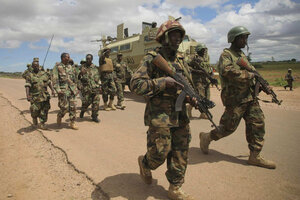Somalia: Al Shabab loses Afgoye and Afmadow. Is Kismayo next?
Military advances by African Union troops and Somali forces have pushed the Islamist Al Shabab militia out of key towns. Is the Shabab headquarters of Kismayo next on the list?

African Union Mission in Somalia (AMISOM) troops walk down the road between Afgoye and Baidoa after arriving in the town of Afgoye, west of the Somali capital Mogadishu, in this handout photo released on May 25.
Stuart Price/AU-UN Information Support Team/REUTERS
• A version of this post appeared on the blog "Sahel Blog." The views expressed are the author's own.
On Friday, troops from Somalia’s Transitional Federal Government (TFG) and the African Union Mission in Somalia (AMISOM) captured the town of Afgoye from the rebel movement al Shabab, in what the Associated Press called “the biggest victory over al-Shabab since the pro-government forces took control of the capital last August” (more here). Further south, troops from the Kenyan Defense Forces (KDF), who have been fighting in Somalia since October, took the town of Afmadow from al Shabab some time between yesterday and today (Kenyan troops also took the town of Hayo). The KDF’s next major goal is tocapture the port city of Kismayo – al Shabab’s “last key bastion” – by August.
McClatchy says the importance of Kismayo lies in the fees al Shabab charges at the port. Its loss would therefore deprive the group not only of territory but of much of its income.
Brief fighting occurred in Kismayo earlier this week, when Kenyan warships reportedly came under fire and shelled the city in response. “For the past couple of months,” VOA says, “Kismayo has come under fire targeting al-Shabab from air and sea.”
Here is a map showing Afgoye, Afmadow, and Kismayo, as well as the capital Mogadishu.
Military conquests by the government and its allies are coming at the same time as some political progress – namely a framework for holding presidential elections by August 20. This combination has generated significant optimism about Somalia’s future. It is important to note, though, that there has been some criticism of and disagreement with that line. Dayo Olopade, for example, notes that the Kenyan intervention in Somalia has lasted much longer than Kenyan leaders first implied it would, and decries “unacceptable side effects” of the conflicts, namely bombings inside Kenya that seem to be reprisals by al Shabab and its sympathizers. Roland Marchal, meanwhile, asks important questions about what political arrangements conquerors will create in areas formerly held by al Shabab:
The question is, and we see that everywhere, what kind of political answer you give to the population after having beaten Shabaab. In Beledweyne and Boosaaso, two big cities that have been taken from Shabaab, the Ethiopians promoted their friends, their allies. That makes a lot of sense. But if you don’t have local reconciliation with clans that explicitly supported Shabaab – because they had some good interest to do that, some very real interest beyond the jihaadi rhetorics – if you don’t do that, then sooner or later you create tensions and new problems come up.
[...]
So if you look at the very short term, you may believe that there are still incidents, but there is no longer a battle, and therefore the situation is going to improve. If you take a longer perspective, however, then it becomes a very concerning issue. Look at Mogadishu: the number of people who were killed last week is basically the same as the number of people who were killed ten or twelve weeks ago, so that means that the intensity hasn’t diminished. What has changed is the targeting.
To put it in a nutshell: it is very dangerous for the Somalis and the international community to assess the condition of the current war with the parameters of what was the war in 2011. And I believe that is exactly the mistake the Ethiopians made in 2007. They had been able to crush Shabaab in December [of 2006] in a very easy and very radical manner, because they fought face-to-face, and of course Shabaab couldn’t confront a professional army and therefore lost with many casualties. But then Shabaab shifted to an urban-style guerrilla, and that created a new problem for the Ethiopian army.
What do you think? Where is this all headed?
– Alex Thurston is a PhD student studying Islam in Africa at Northwestern University and blogs at Sahel Blog.

